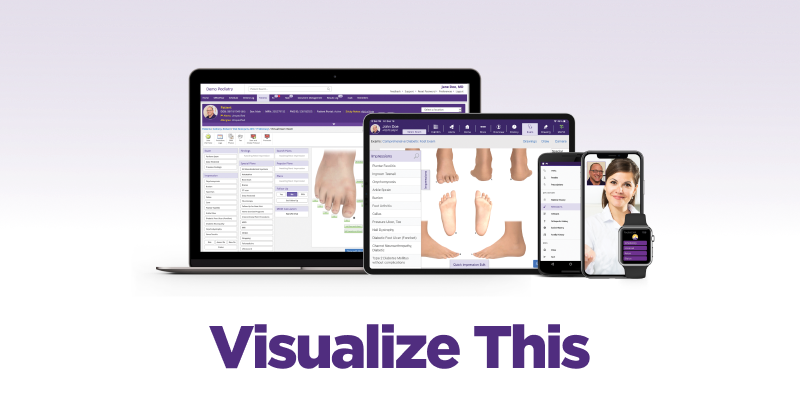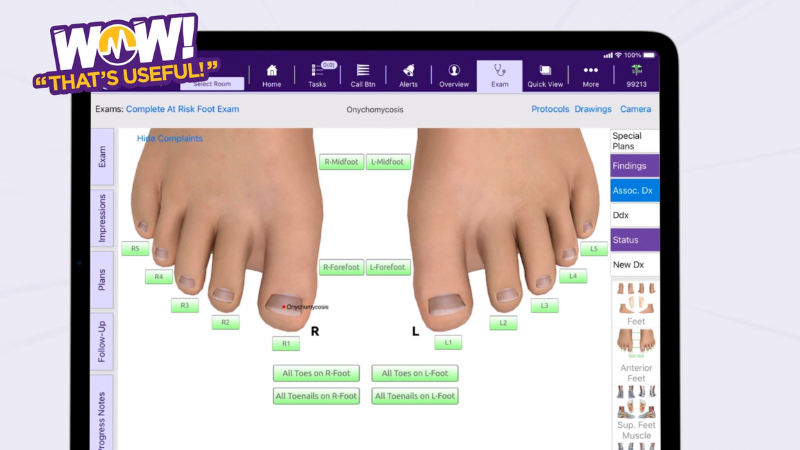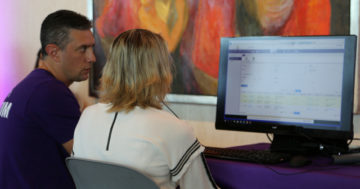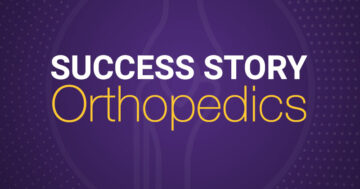Step Up Your Podiatry Exams With the ModMed Interactive Anatomical Atlas

See how an integrated visual atlas can help with documentation and education
The ModMed® Interactive Anatomical Atlas™ is a specialty-specific visual tool that allows podiatrists to access three-dimensional illustrations of the feet and lower extremities. Illustrations are layered and interactive, so you can “peel back” the layers to work with visuals of muscles, joints, tendons, ligaments and nerves.
This level of detail helps providers thoroughly document visits and engage patients in their care. The integration of visual aids can help providers explain diagnoses, treatments and outcomes more clearly, while creating a more collaborative and engaged care environment.
In this blog post, we will explore how the Interactive Anatomical Atlas can help podiatrists with documentation and education, improving workflows and patient engagement.
Integrated Patient Documentation
Annotated illustrations and integrated photography are key features of the ModMed electronic health records (EHR) system for podiatrists. Integrated photography is not part of the atlas itself, but the two are frequently used in tandem. The photography integration is on the same screen as the virtual workflow in your EHR.
Annotated Illustrations

Once a provider makes an annotation on an image, the image with annotation is time-stamped and attached to the patient’s records.
Providers can write or draw freehand on images to help explain conditions and treatments to patients. This streamlines the documentation process for podiatrists and their assistants, allowing them to finalize visits with more ease and convenience.
When communicating treatment plans, these annotations can be particularly useful. They can allow providers to make notes or indicate specific parts of the foot and ankle anatomy to patients and explain how the area will be treated. By becoming part of the patient’s record, the notes also become evidence of communication to guide future treatments or decisions.
Integrated Photography
Integrated photography is also a significant feature of the ModMed podiatry EHR. Podiatrists can take photos on their iPads, show them to patients, and instantly attach them to specific parts of the electronic patient record.
The incorporation of photography into your podiatry EHR is significant because it eliminates the need to import or attach images later in the documentation process. Not only does this create a more streamlined workflow but also it helps support compliance, compared to scenarios where providers may take pictures with their smartphones and then manually attach them later.
An example of one way podiatrists use this feature is with diabetic foot conditions like ulcers. Detailed images can provide valuable information about the patient’s progress over time and help patients see things like the difference before and after debridement.
Sharing Images
The ease with which podiatry practices can share images is another advantage of the Interactive Anatomical Atlas.
Patient Portal
Patients can access annotated images from their records in the ModMed Patient Portal, where they can also review and update their history, schedule appointments, access lab results, and communicate with your practice. Patient portals can also help your practice by reducing administrative tasks and paperwork, streamlining patient-provider communication, and increasing patient engagement.
Other Providers
The atlas can facilitate collaboration between podiatrists and referring physicians. Practices can also share images with labs or partners to coordinate care across teams.
By sharing visual information about a patient’s condition, both parties can work together to develop an appropriate treatment plan. This level of coordination can help streamline care, control costs and help improve patient satisfaction.
Billing
Annotated images can help podiatrists communicate more effectively with payers. By highlighting specific areas of concern or pointing out key diagnostic features, podiatrists can make it easier for payers to understand the nature and severity of a patient’s condition.
Annotated images can also provide evidence to support the treatment decisions made by podiatrists. By documenting the specific findings that led to a particular course of treatment, podiatrists can demonstrate to payers the medical necessity of proposed interventions.
Patient Engagement
Patient engagement is crucial for improving health outcomes and building rapport with patients. ModMed’s Interactive Anatomical Atlas can be used to support patient engagement by providing detailed anatomical illustrations that are easy for patients to understand.
Patient Education
Patient education is also an essential aspect of patient engagement. The detailed anatomical illustrations available through the Interactive Anatomical Atlas make it easier for patients to understand their diagnoses and treatments, leading to better communication and collaboration between patients and providers.
By involving patients in their care more closely, podiatrists may be able to improve adherence to treatment plans and ensure better outcomes.
Working With the Podiatry Atlas
The Interactive Anatomical Atlas is a powerful tool for podiatrists to improve their workflows and patient engagement. The integration of annotated illustrations and integrated photography into electronic health records helps streamline documentation and supports collaboration between podiatrists and other providers. Moreover, patient engagement may be improved through detailed anatomical illustrations that help patients understand their diagnoses and treatments.
Get started now using the ModMed Interactive Anatomical Atlas for podiatry. Book a demo to see the atlas in action.
This blog is intended for informational purposes only and does not constitute legal or medical advice. Please consult with your legal counsel and other qualified advisors to ensure compliance with applicable laws, regulations and standards.







